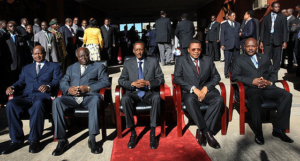The Promise of the East African Federation
 A proposed federation between Burundi, Kenya, Rwanda, South Sudan, Tanzania, and Uganda seeks to establish a single currency, political unity, modern infrastructure, improved trade relations and ensured peace. In the 1960s, when many of the above countries won their independence, a political federation was first proposed. Today, all six countries are members of the East African Community (EAC), which started in 1999 as a less ambitious form of unity. The East African Federation remains mostly an idea; however, leaders in all six countries are now working together to see the idea come to fruition.
A proposed federation between Burundi, Kenya, Rwanda, South Sudan, Tanzania, and Uganda seeks to establish a single currency, political unity, modern infrastructure, improved trade relations and ensured peace. In the 1960s, when many of the above countries won their independence, a political federation was first proposed. Today, all six countries are members of the East African Community (EAC), which started in 1999 as a less ambitious form of unity. The East African Federation remains mostly an idea; however, leaders in all six countries are now working together to see the idea come to fruition.
Where it Stands
The countries began drafting a unified constitution in 2018, which would render each member’s individual constitution subordinate to that of the East African Federation. They have set the deadline for its completion to 2021. The EAC has already neared completion of a monetary union, likely being something akin to the European Union’s euro. The euro has allowed for the free movement of capital, stimulating trade activity between member states. Additionally, all six countries are planning to hold a referendum with their own citizens in order to gauge support.
Ambitions
The countries’ leaders say that a federation will lead to economic development and greater African sovereignty. The advantages of the East African Federation include linkages of infrastructure, which will allow four of the landlocked members to have access to the trading ports of Kenya and Tanzania. Further, the East African Federation, due to its enormity, will have more influence in international diplomacy, and its governmental institutions will become more robust through information sharing.
Limitations
When integration efforts were attempted in the past, they became derailed by individual national interests and existing tensions. While the East African Federation attempts to overcome these tensions, some doubt its ability to do so. Critics point to trade disputes between Rwanda and Uganda and military rivalries between Tanzania and Rwanda as prominent examples for why unity will remain unaccomplished.
The Promise
East Africa’s economy is the fastest-growing on the continent; GDP increased by 5.7 percent in 2018 and is forecasted to hit 5.9 percent in 2019. According to the World Bank’s most recent data, the average poverty rate for the 6 countries is 49.6 percent. Kenya has the lowest rate with 36.8 percent, and Burundi has the highest with 71.8 percent. The East African Federation promises to improve cooperation methods and increase economic potential, yielding greater growth, quicker development and lasting stability for the region.
– Kyle Linder
Photo: Flickr
